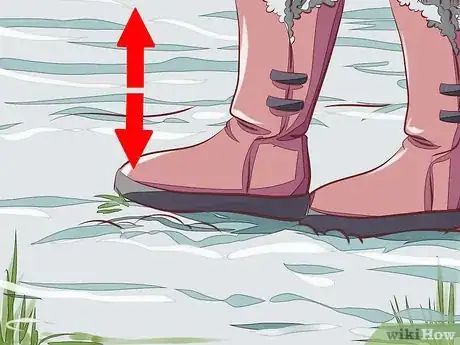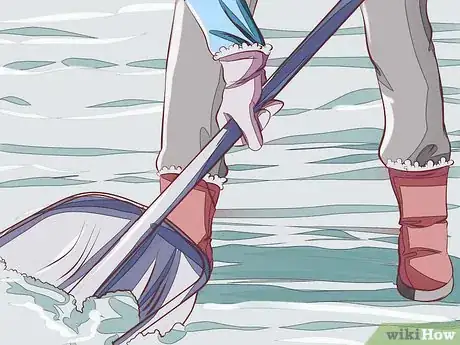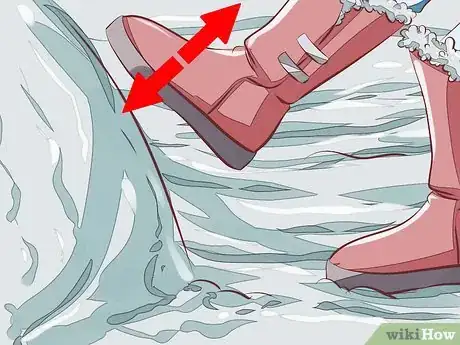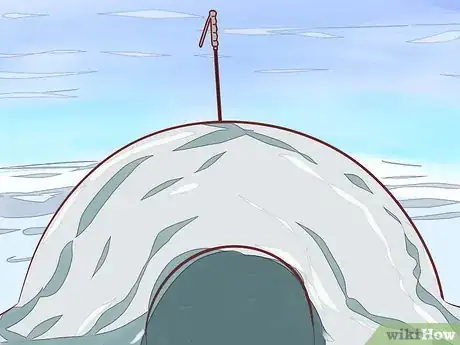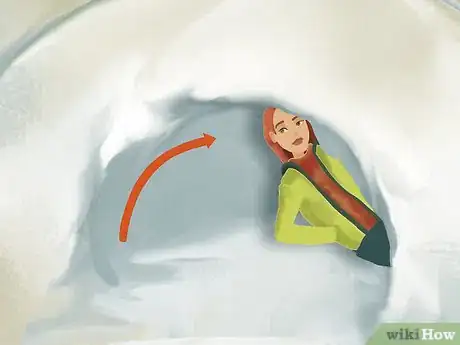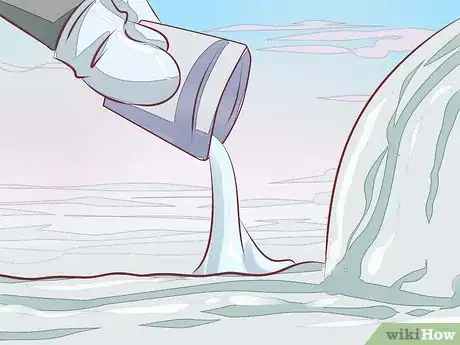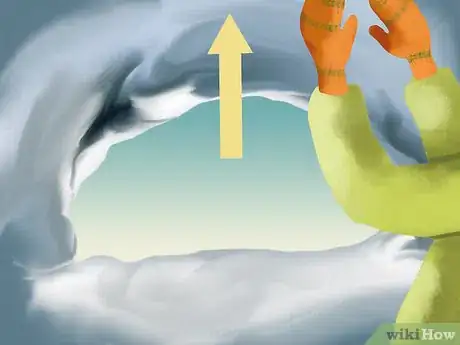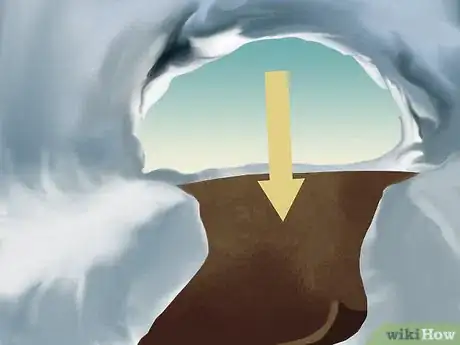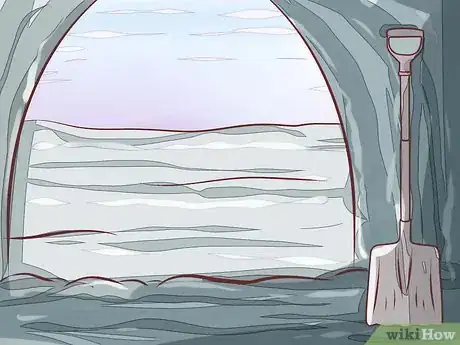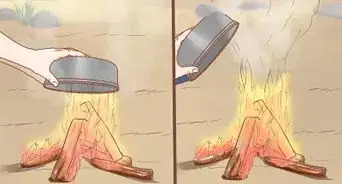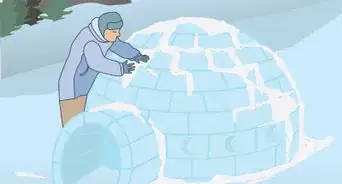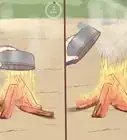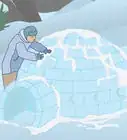wikiHow is a “wiki,” similar to Wikipedia, which means that many of our articles are co-written by multiple authors. To create this article, 68 people, some anonymous, worked to edit and improve it over time.
There are 8 references cited in this article, which can be found at the bottom of the page.
wikiHow marks an article as reader-approved once it receives enough positive feedback. In this case, several readers have written to tell us that this article was helpful to them, earning it our reader-approved status.
This article has been viewed 322,112 times.
Learn more...
Need to build an emergency shelter in the snow? Do you intend to camp out in the snow on a ski trek? Or are you trying to build the best snow fort your town has ever seen? Just want to relax? No matter what your reason is, make sure you follow each step carefully so your snow cave won't collapse on top of you. If you're willing to put in a few hours of hard work, and the snow conditions are right, you can make a snow cave to be proud of.
Steps
Selecting a Spot and Preparing
-
1Avoid areas of rockfall or windy slopes. Take care not to dig a snow cave under the path of a potential avalanche or rockfall. Slopes with the wind blowing against them could be dangerous if you are staying overnight, as blowing snow could clog the entrance tunnel and block access to the outside air.
-
2Find an area with deep snow. If you can find a snowdrift at least five feet (1.5m) deep, a lot of your work will be done for you. Look for areas where the wind has blown the snow against a slope. Keep in mind you'll also need an area large enough to house however many people you have. A ten foot (3 m) diameter cave is comfortable for two or three people.Advertisement
-
3Test the consistency of the snow. Light, powdery snow may be difficult to work with, and is more likely to collapse. Fortunately, snow tends to harden once disturbed, so if you have the time to pile it up and wait for it to harden, you will likely still be able to form it into a snow cave.[1]
-
4If conditions aren't right, consider a trench instead. If you are in an emergency situation, one alternative is to dig a trench in the snow and use a tarp to cover it. Prop the tarp up with ski poles or branches stuck in the snow. This is easier and faster to dig, but will not provide the same warmth as a snow cave, and could become buried in a snowstorm.
-
5Check that you have the clothing and equipment you need. Warm, waterproof clothing is essential if you are out in the wilderness. Consider removing one or two dry under-layers of clothing before you begin working so you have something to change into if your clothing gets wet while digging. As for equipment, a compact snow shovel or two will make the snow cave's construction much easier. A non-smoke-producing light source is useful for overnight stays, but a candle or other small flame source can be used if you remember to create a ventilation hole.
- Ventilation holes are described further on in this article.
-
6Find a friend to help. Having at least two people build a cave together is highly recommended. Keep one person outside of the cave with a spare shovel at all times. This way, if the cave collapses during the digging, the person on the outside can shovel away the snow to rescue the person trapped inside.
Hollowing Out the Cave
-
1Work slowly but methodically. Work in shifts if you have more than one person, and take breaks for eating and drinking. Working slowly but efficiently, without breaking a sweat, will keep you warmer and safer than trying to rush the job. Sweating can cause heat loss, which increases the risk of hypothermia.[2]
-
2Pile up the snow if necessary. Unless the snowdrifts in your area are deep enough already, you'll need to shovel the snow into a pile at least five feet (1.5m) tall, and large enough to fit the number of people it will be sheltering.
- A quick way to pile up snow is to find a short slope and use your shovel to push the snowdrift down to the base of the slope.[3] Beware of taller slopes with additional snowdrifts higher up, however, as your snow cave could be buried in an avalanche.
-
3Pack the snow firmly. Pack the snow pile or snowdrift by stomping on it with snowshoes or laying a plywood board over it and stomping on that. If the snow is light and powdery, you may wish to pack it down several times as you create the snow pile, in addition to a final pack when the pile is tall enough.
-
4Allow two or more hours for the cold air to harden your snow pile. This makes the snow firmer and will reduce the risk of the cave from collapsing in on you while you dig it out. Waiting at least two hours is recommended, and you may need to wait up to 24 hours if the snow is powdery and dry.
-
5Dig a tunnel into the snow. If you made a snow pile, dig a tunnel easily wide enough to crawl through and several feet deep, sloping upward. If you are digging into a deep snowdrift, dig a trench 5 or more feet down for you to stand in, then dig a tunnel at the base of the trench.[4] You may find this easier if you have a compact snow shovel, available at backpacking or mountaineering stores.
- If you are building a snow cave for fun and don't mind taking extra time, you can avoid some discomfort by digging a "doorway" several feet tall instead of a tunnel. Once you've completed the snow cave, wall up most of the doorway with additional snow, leaving a tunnel to exit through.[5]
-
6Stick ski poles or branches into the snow pile as a guideline. Stick these objects about 12–18 inches (30–46cm) into the snow pile. While digging out the snow cave from the inside, stop when you encounter these objects. Without this guideline, you may accidentally dig the ceiling too thin and expose your snow cave to the elements, or even cause a collapse.
-
7Hollow out the dome of the cave. Shovel snow from the center of the pile or snowdrift out through your tunnel. Once you've hollowed out enough room for your whole body at the end of the tunnel, you can stay there and use your feet to push the snow through the tunnel.[6] Make sure the ceiling of the snow cave remains at least 1 foot (0.3m) thick to minimize the chance of collapse. The sides should be several inches (8 or more cm) thicker than the ceiling.
- Try to make the floor of the cave higher than the entrance. This will keep the sleeping area warm as the cold air gathers in the entrance tunnel.
Finishing the Cave
-
1In freezing temperatures, strengthen the cave by pouring water over the outside. If the temperature is below freezing and you have water to spare, pour water over the outside of the cave. This will freeze into ice and create a sturdier structure.
- Never pour water over the cave if the temperature is above freezing.
-
2Smooth the inside roof and walls to prevent dripping. Scrape the walls and roof of the cave to make it smooth. Irregular, bumpy surfaces will drip water onto the cave floor, instead of directing water down the walls to gather around the edges.
- If dripping is still a problem, carve grooves leading down the walls.
-
3Mark the outside of the cave. Use brightly colored gear or conspicuously placed branches to mark the edge of your cave. This may help people find the cave again, and stop them from walking on the roof and causing a collapse.
- If you are in an emergency situation awaiting rescue, make sure the gear is visible from the air, not hidden underneath trees or other obstructions.
-
4Carve in benches and sleeping areas as needed. The higher the benches/sleeping platforms are, the better, as cold air will sink below the bench keeping you warmer. You may wish to create shelves for easier gear storage, and a trench to make sitting or standing easier.
-
5Create ventilation holes. Snow caves can become quite insulated from the outside air, especially if moisture from your breath creates an icy layer on the inside wall. To prevent suffocation, use a ski pole or other long object to create an angled hole or two at the slanting edge of the roof. Make sure this hole goes all the way through the roof.
- Because ventilation holes will cause some warm air to escape, you may wish to cover the hole with a snowball or other object, then remove it if the air feels stuffy or anyone feels dizzy. Remove the object before you go to sleep.
-
6Cover the ground with insulating material. Gather pine branches to place on the floor of the cave, to slow the escape of warmth through the ground. Sleep on camping pads, but be aware that inflatable pads may not keep you warm in cold weather.
-
7Move your shovels inside. While staying in the cave, always make sure you have shovels inside with you so you can dig yourself out in case of collapse or a blocked entrance. Shovel the entrance out regularly during a blizzard.
- If too much warm air is escaping through the entrance, block it with a backpack or other easily removed object. Do not wall yourself up.This will also help you hide from animals such as mountain lions and bears.
Community Q&A
-
QuestionCan a dog go into my snow cave?
 Community AnswerYes, but it might make the cave become more stuffy faster, because a dog tends to pant. If you do, consider having an air hole or two.
Community AnswerYes, but it might make the cave become more stuffy faster, because a dog tends to pant. If you do, consider having an air hole or two. -
QuestionHow do I build a snow cave with no snow?
 Community AnswerI'm afraid that is impossible. A snow cave is called a snow cave because it is made out of snow. Regular caves are natural so you cannot make one.
Community AnswerI'm afraid that is impossible. A snow cave is called a snow cave because it is made out of snow. Regular caves are natural so you cannot make one. -
QuestionHow can I cook in or heat a snow cave?
 Community AnswerYou can't, this will cause the snow to melt and your cave will collapse. But, you can make a fire outside by clearing an area about 20 feet from the snow cave. Also, make sure to wear warm clothes with layering to stay warm.
Community AnswerYou can't, this will cause the snow to melt and your cave will collapse. But, you can make a fire outside by clearing an area about 20 feet from the snow cave. Also, make sure to wear warm clothes with layering to stay warm.
Warnings
- If you plan to sleep several days in your snow cave, make sure to scrape an inch or two of melted snow off of the walls after each night. This keeps the snow porous and lets moisture escape to the outside instead of gathering inside the cave and soaking the people inside.⧼thumbs_response⧽
- Building a snow cave is hard work. Be sure to have others to help share the load and have one person in charge of preparing energy-rich, hot food to supply the working team with.⧼thumbs_response⧽
- Always leave the entrance uncovered if you have a candle or other flame. Even using a small cooking stove or candle can be lethal, as it can lead to a buildup of carbon monoxide. Carbon monoxide is only slightly lighter than air, and small ceiling air holes may not be enough to vent the gas.[7]⧼thumbs_response⧽
- Building a fire or running a stove inside is not recommended, as it uses up oxygen and produces dangerous gas. It can also cause the snow to melt, then freeze into a layer of ice. This traps moisture in the cave, soaking the inhabitants.[8]⧼thumbs_response⧽
Things You'll Need
- Snow (Best if easy to mold and shape)
- Large snow shovel
- Hand shovel or trowel
- One or more assistants
- Ice axe/pick (optional)
References
- ↑ http://www.motherearthnews.com/diy/snow-caves-and-winter-shelters-zmaz82ndzgoe.aspx#axzz39J0HG32H
- ↑ http://www.wildernesscollege.com/causes-of-hypothermia.html
- ↑ http://www.motherearthnews.com/diy/snow-caves-and-winter-shelters-zmaz82ndzgoe.aspx?PageId=1
- ↑ http://www.etisurvival.com/snocv.htm
- ↑ http://www.motherearthnews.com/diy/snow-caves-and-winter-shelters-zmaz82ndzgoe.aspx?PageId=3#axzz39J933agE
- ↑ http://www.etisurvival.com/snocv.htm
- ↑ http://healthybuildingscience.com/2013/02/22/carbon-monoxide-facts/
- ↑ http://www.motherearthnews.com/diy/snow-caves-and-winter-shelters-zmaz82ndzgoe.aspx?PageId=4#ArticleContent
- How to Build an Igloo -- and Other Show Shelters, by Norbert E. Yankielun, W.W. Norton and Co.. New York, 2007.
About This Article
To build a snow cave, start by finding a buddy to work with, so one person can stay outside the cave in case it collapses. Then, find a place where the snow is deep and compact, and make a pile of snow at least 5 feet tall. Wait 2 hours for the cold air to harden it, then use a shovel to dig a tunnel wide enough for you to crawl through. Next, dig upward to hollow out the dome of the cave, and make sure to leave the ceiling 18 inches thick so it won’t collapse. If the temperature is below freezing, you can pour water over the outside of the cave for even more support. For tips on how to carve benches or sleeping areas into your snow cave, read on!


